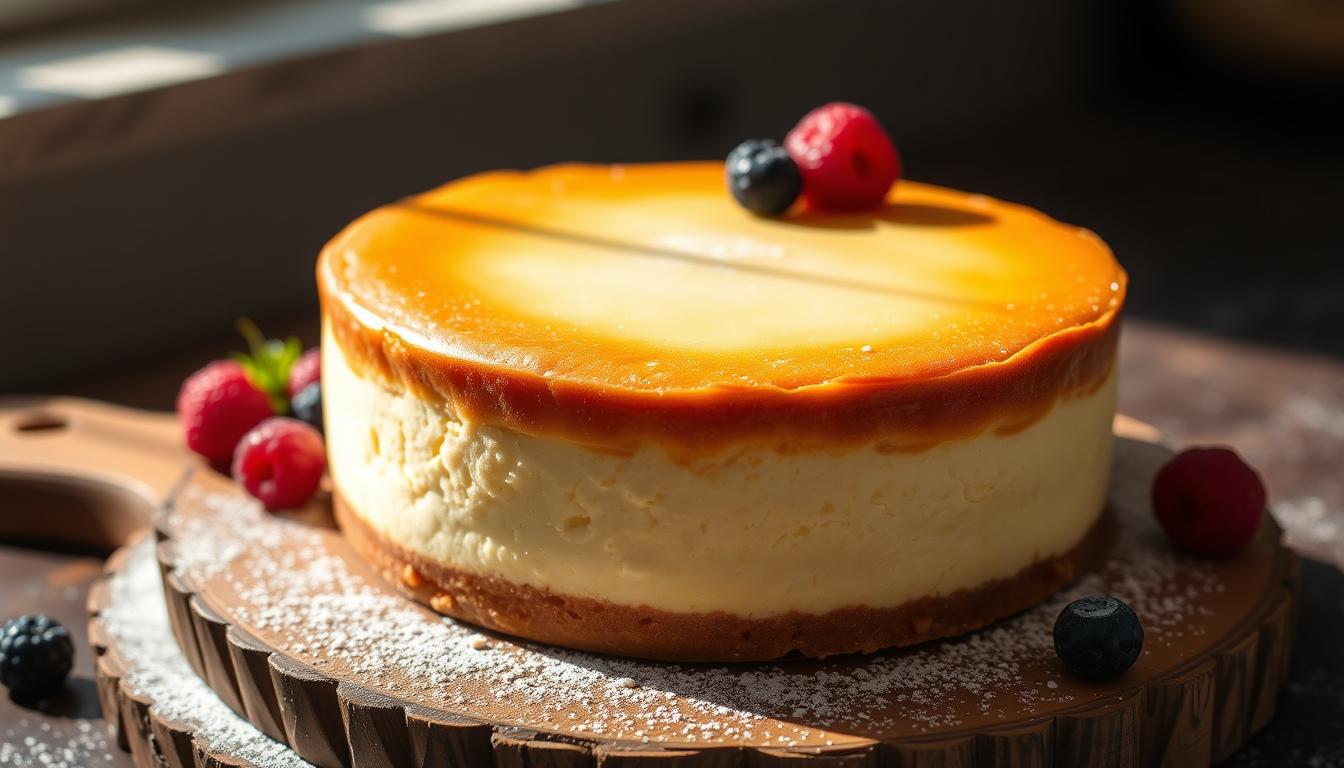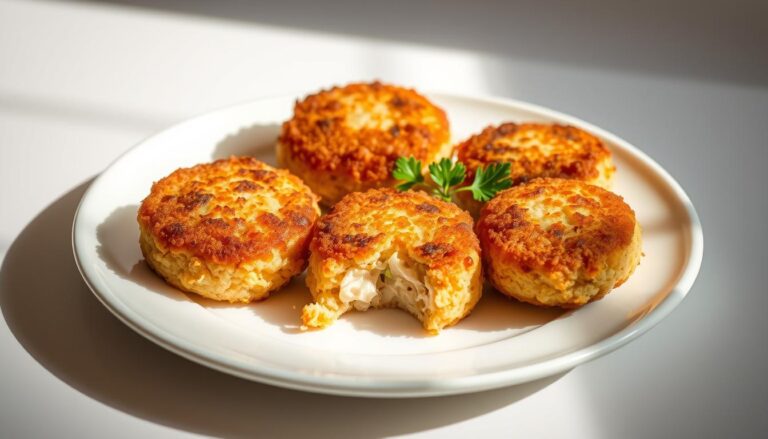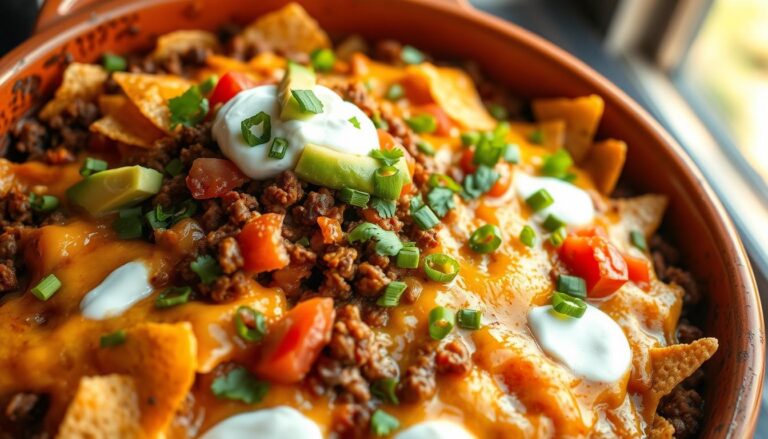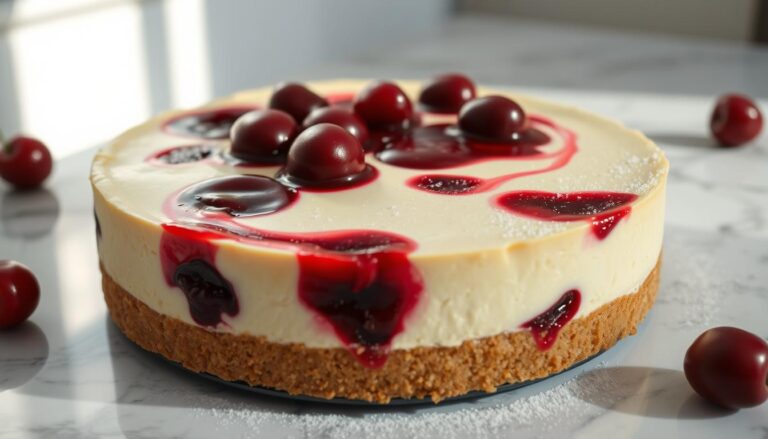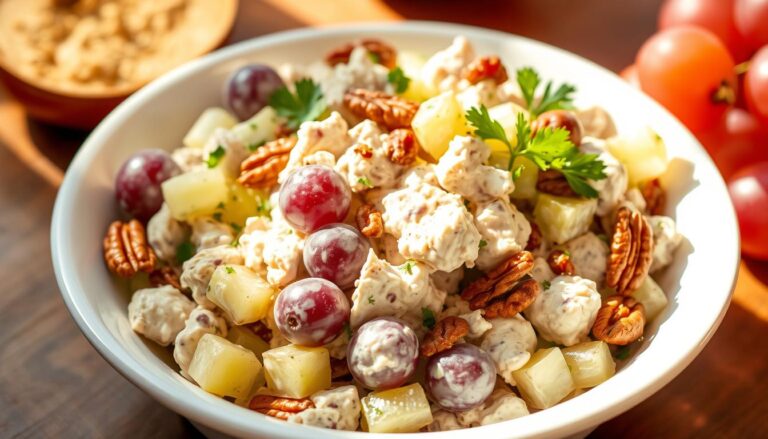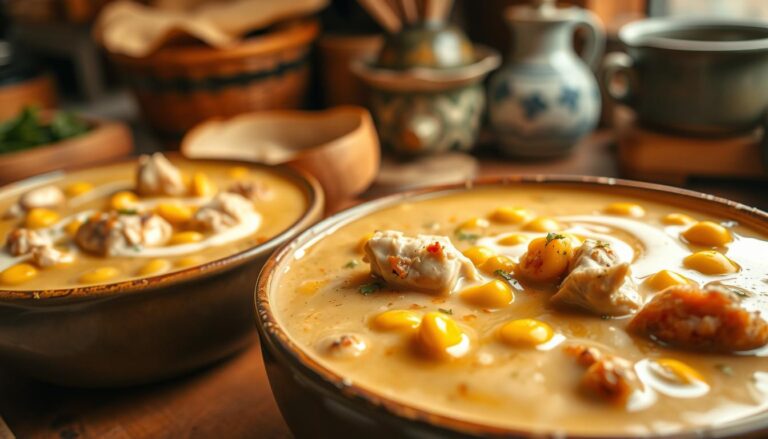Bake the Iconic San Sebastian Cheesecake at Home
A creamy, caramelized masterpiece from Spain’s Basque Country has taken the dessert world by storm. You might be wondering, what’s behind the hype? The San Sebastian cheesecake has won many hearts with its unique texture and flavor.
You can now make this iconic dessert at home. It has a caramelized top and a creamy inside. It’s sure to wow your friends and family. We’ll show you the history, essential ingredients, and a step-by-step recipe to get that perfect burnt top
Table of Contents
The Story Behind San Sebastian Cheesecake
In the late 1980s, a new dessert was born in San Sebastian, Spain. The San Sebastian cheesecake, also known as the Basque cheesecake, was created by chef Santiago Rivera. It quickly became a favorite around the world.
Origins in Basque Country
The San Sebastian cheesecake comes from the Basque Country’s rich food culture. Chef Santiago Rivera made it by mixing traditional cheesecake recipes with something new. The result was a cheesecake with a burnt, caramelized crust that changed the game.
What Makes It Different from Other Cheesecakes
So, what makes the San Sebastian cheesecake special? It’s the mix of creamy inside and burnt outside. This unique texture, along with simple ingredients, makes it stand out. Here’s a quick comparison:
| Characteristics | San Sebastian Cheesecake | Traditional Cheesecakes |
|---|---|---|
| Texture | Creamy interior, burnt exterior | Dense and smooth |
| Preparation | High-temperature baking | Low-temperature baking, often with a water bath |
| Crust | No crust, caramelized top | Often has a crust made of graham cracker or pastry |
Essential Ingredients for an Authentic San Sebastian Cheesecake
The secret to a real San Sebastian cheesecake is in its ingredients. You need the right stuff to get that burnt top and creamy inside. Let’s explore what makes this dessert so special.
Quality Cream Cheese Selection
Choosing the right cream cheese is key. Go for a high-quality, full-fat cream cheese like Philadelphia. It’s essential for the cheesecake’s taste and texture.
The Importance of Fresh Eggs and Heavy Cream
Fresh eggs and heavy cream are crucial. They help balance the cheesecake’s texture. Using top-notch eggs and cream will make your cheesecake stand out.
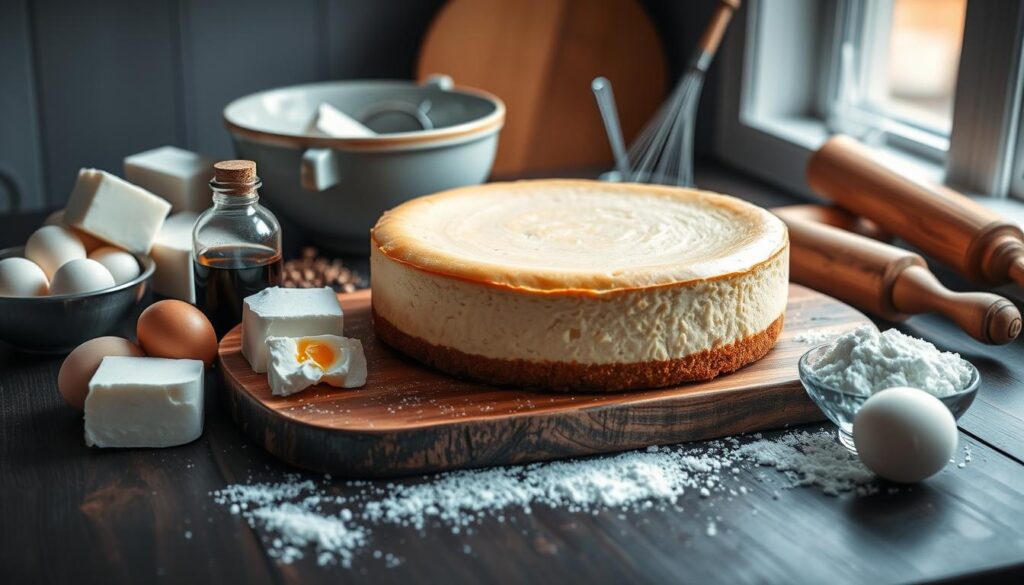
Sugar and Flour Considerations
Sugar adds sweetness and affects the cheesecake’s texture. Use granulated sugar for San Sebastian cheesecakes. A bit of flour helps the cheesecake hold its shape. Make sure to get the right mix.
Optional Flavor Enhancers
Want to add something special? Try vanilla extract or a pinch of salt. They can enhance the flavor without overpowering it.
| Ingredient | Quantity | Purpose |
|---|---|---|
| Cream Cheese | 1 pound | Main component for creamy texture |
| Eggs | 4 large | Provides structure |
| Heavy Cream | 1 cup | Enhances creamy texture |
| Sugar | 1 cup | Adds sweetness and affects texture |
| Flour | 2 tablespoons | Strengthens cheesecake structure |
Equipment You’ll Need
To bake a tasty San Sebastian cheesecake at home, you need the right tools. Having the right equipment makes the baking process smooth and successful. You’ll need specific tools and pans for this.
The Right Baking Pan
A springform pan is key for baking a San Sebastian cheesecake. It makes it easy to remove the cheesecake after baking and cooling. Choose a pan that’s at least 8 inches wide to fit the cheesecake.
Parchment Paper Techniques
Parchment paper stops the cheesecake from sticking to the pan. Cut a piece for the bottom and another for the sides. This helps the cheesecake come out of the pan easily.
Mixing Tools and Oven Requirements
You’ll need a mixer, either stand or handheld, to beat the cream cheese and eggs. A rubber spatula is also necessary for scraping the bowl’s sides. For baking, a conventional oven works well. Make sure it’s preheated right. Using a thermometer can help check the oven’s temperature.
Preparing Your Kitchen for Success
To make a great San Sebastian cheesecake, start with a clean kitchen. Here’s how to get your kitchen ready for this creamy cheesecake from Spain.
Setting Up Your Workspace
Clear your countertops and make sure you have enough room to work. Collect all the ingredients and tools you need, like mixing bowls and measuring cups. This makes baking easier and less likely to go wrong. A tidy workspace is key for baking well.
Preheating and Timing Considerations
Preheat your oven to the right temperature, as the recipe says. Knowing your oven’s quirks is important for baking times. Use an oven thermometer to check the temperature. Plan your baking time, including prep and baking.
| Task | Time Required |
|---|---|
| Preheating Oven | 15 minutes |
| Preparing Ingredients | 10 minutes |
| Baking Cheesecake | 25 minutes |
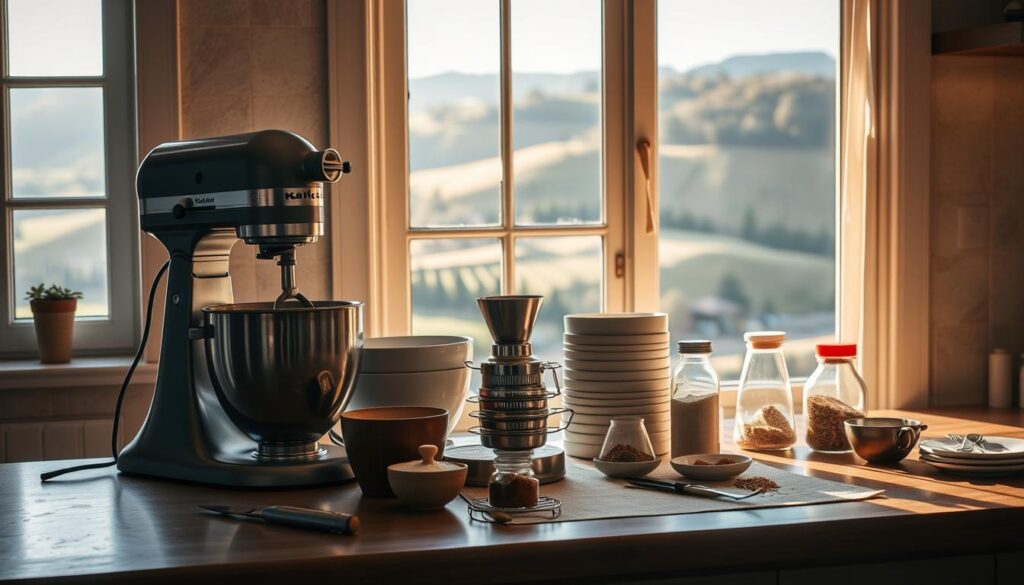
Step-by-Step San Sebastian Cheesecake Recipe
To make a San Sebastian Cheesecake, follow these steps. You’ll learn to mix ingredients, prepare the pan, and bake it perfectly. This guide will help you achieve a creamy inside and a burnt top.
Bringing Ingredients to Room Temperature
Make sure all ingredients are at room temperature before mixing. This helps the cream cheese soften and the eggs mix well. Take the cream cheese, eggs, and heavy cream out of the fridge an hour before starting.
Mixing the Perfect Batter
Mixing is key to a great San Sebastian Cheesecake. It involves several steps to get the right texture and flavor.
Incorporating Cream Cheese
Begin by beating the cream cheese until it’s smooth. This step is crucial for a creamy texture. Use an electric mixer on medium speed for the best results.
Adding Eggs and Sugar
Add eggs one at a time, making sure each is fully mixed before adding the next. Then, mix in the sugar until it’s dissolved. This makes the batter smooth and creamy.
Final Mixing Techniques
Next, add the heavy cream and mix until the batter is smooth. Be careful not to overmix, as this can cause the cheesecake to crack.
Preparing the Baking Pan
To make the cheesecake easy to remove, prepare the pan well. Line it with parchment paper, covering the bottom and sides. This prevents sticking and makes release easy.
Pouring and Smoothing the Batter
Pour the batter into the prepared pan. Use a spatula to smooth the top. This ensures an even bake and a beautiful burnt top.
Baking Times and Temperatures
Bake the cheesecake at a high temperature. A common setting is 425°F (220°C) for about 25 minutes. Keep an eye on it to get the perfect burnt top.
Achieving the Perfect Burnt Top of San Sebastian Cheesecake
Making a San Sebastian cheesecake right means getting the burnt top just right. This look is not just for show. It shows the cheesecake is made the traditional way.
Oven Positioning for Optimal Caramelization
To get that perfect burnt top, place your cheesecake in the oven carefully. Put it on the top rack, as close to the broiler as you can. This spot helps the top brown evenly.
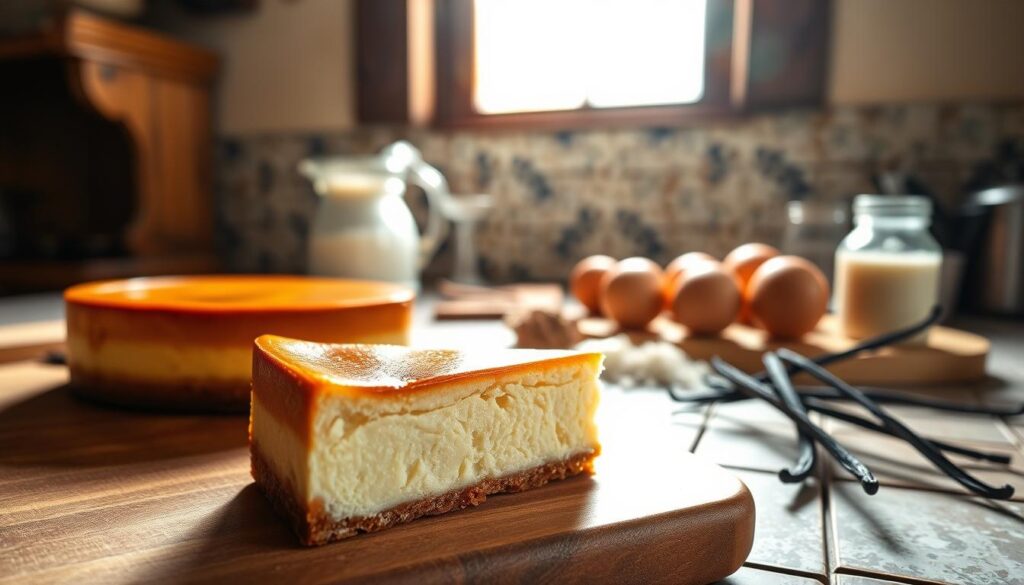
Visual Cues for the Signature Look
Watch your cheesecake as it bakes. The top should start to brown and get a deep golden or almost black color. This means it’s getting its special look. The edges should be firm, and the center should still wobble a bit.
When to Remove from the Oven
It’s important to know when to take the cheesecake out. When the top is nicely browned and the edges are set, it’s time. Don’t overbake, as it can make the cheesecake dry. The center should still feel a bit soft when you take it out.
The Critical Cooling and Setting Process
After baking your traditional Basque cheesecake, the next step is cooling and setting. This is key for the right texture and consistency.
Initial Cooling Period
Take the cheesecake out of the oven and let it cool in the pan. This initial cooling helps it set and makes it easier to handle. It’s important to cool it slowly to avoid cracks.
Refrigeration Guidelines
Move the cheesecake to the fridge after cooling. For a traditional Basque cheesecake, chill it for at least 4 hours or overnight. This step is vital for proper setting and flavor maturation.
How to Tell When It’s Properly Set
To see if your cheesecake is set, gently jiggle the pan. If the edges are firm and the center jiggles a bit, it’s set. You can also check by inserting a knife or toothpick near the center. If it comes out clean or with a few moist crumbs, it’s ready. Proper setting is essential for a top-notch traditional Basque cheesecake.
By following these steps, your San Sebastian cheesecake will be perfect. It will have a creamy texture and a beautifully burnt top.
Troubleshooting Common San Sebastian Cheesecake Problems
Mastering the best San Sebastian cheesecake recipe means solving common problems. Issues like cracks, sinking, texture issues, and imbalanced flavors can happen. We’ll cover these problems and offer solutions to make your cheesecake perfect.
Preventing Cracks and Sinking
Cracks and sinking are common in cheesecakes. They often come from sudden temperature changes or uneven baking. To avoid cracks, cool your cheesecake slowly in the oven with the door ajar. Sinking can be lessened by not opening the oven door and using a water bath for a stable temperature.
Fixing Texture Issues
Texture problems, like a dense or jiggly cheesecake, come from wrong mixing or baking times. Overmixing makes it dense, while underbaking makes it jiggly. To get the right texture, mix just until combined and bake until the edges are set and the center is slightly jiggly.
“The key to a creamy cheesecake is not overmixing the batter and baking it until it’s just set.” –
Adjusting Sweetness and Flavor
You can adjust the sweetness and flavor of your San Sebastian cheesecake. To make it less sweet, reduce the sugar. For more flavor, add vanilla or citrus zest to your batter.
By using these troubleshooting tips, you’ll make a delicious and beautiful San Sebastian cheesecake.
Creative Variations and Serving Ideas
Mastering the classic San Sebastian cheesecake recipe is just the start. Now, it’s time to explore unique twists and serving ideas. The easy San Sebastian cheesecake is perfect for experimenting with different tastes and dietary needs.
Flavor Infusions and Add-ins
Try adding new flavors to your cheesecake batter. Use vanilla or citrus extracts, or mix in chocolate chips, nuts, or dried fruits. For example, a creamy cheesecake from Spain can get a boost from lemon zest or caramel sauce.
Dietary Adaptations
Adapting the San Sebastian cheesecake recipe for different diets is easy.
Gluten-Free Options
For a gluten-free version, swap flour for almond flour or a gluten-free blend. Make sure your cream cheese and other ingredients are gluten-free too.
Lower-Sugar Alternatives
Lower the sugar by using natural sweeteners like stevia or monk fruit. Spices like cinnamon or nutmeg can also add flavor, reducing sugar needs.
Elegant Presentation Techniques
The way you present your San Sebastian cheesecake can be as stunning as its taste. Dust the top with powdered sugar, arrange fresh fruits around it, or serve with caramel or chocolate sauce. For extra elegance, garnish with edible flowers or microgreens.
Conclusion
Now you know how to make a real San Sebastian cheesecake. It’s time to start baking. With the right steps and ingredients, you can make this famous dessert at home. The secret is in keeping it simple and using top-notch ingredients.
Making a San Sebastian cheesecake needs careful steps. From picking the best cream cheese to getting that perfect burnt top. Follow this guide, and you’ll make a creamy, caramelized cheesecake that will wow everyone.
Don’t worry if it seems hard at first. With a bit of practice, you’ll get the hang of it. Soon, you’ll be able to enjoy this beloved dessert whenever you like. Happy baking, and enjoy your homemade San Sebastian cheesecake!

